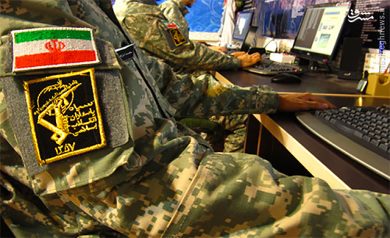In the 21st century, state repression is no longer confined to prisons, police batons, and courtroom show trials. It is encoded in surveillance algorithms, deployed by trolls, hidden in spyware-laced apps, and enforced through shutdowns of entire digital ecosystems. In Iran, the regime’s most powerful cyber actor—the Islamic Revolutionary Guard Corps (IRGC)—has turned the internet from a platform of liberation into an instrument of control.
This article explores how the IRGC has built a “digital dictatorship”: a fusion of military intelligence, cyberwarfare, online censorship, and psychological operations designed to suppress dissent, control information, and export terror. It traces the rise of the IRGC’s cyber army, details its operations, and outlines the human cost and global implications of Iran’s most shadowy warfront.
1. The IRGC’s Cyber Command: Rise of a Digital Army
The IRGC began building its cyber capabilities in the early 2000s, following the rise of online activism and Western attempts to restrict Iran’s nuclear program.
Key Events:
• 2009 Green Movement: Protesters used Twitter, Facebook, and SMS to organize. The regime responded with surveillance and online repression.
• 2010s: The IRGC formalized its Cyber Command, investing in domestic hacking, monitoring tools, and AI-based analysis.
• Today: Iran’s cyber army is among the most aggressive in the world—comparable to North Korea’s Lazarus Group or Russia’s APT28.
The IRGC controls this infrastructure through its Intelligence Organization, which often eclipses the Ministry of Intelligence in power and secrecy.
2. Mission: Total Information Control
The IRGC’s cyber doctrine mirrors its ideological mission: to defend the Islamic Republic from internal and external threats—real or imagined.
Objectives:
• Monitor and intimidate dissidents
• Enforce Islamic values in digital spaces
• Prevent “Western cultural invasion”
• Disrupt foreign enemies via cyberattacks
• Protect regime propaganda and silence alternatives
This fusion of cyberwarfare, censorship, and psychological control forms the backbone of Iran’s digital dictatorship.
3. Surveillance and Monitoring Tools
Iran has one of the most sophisticated state surveillance systems in the world—powered largely by the IRGC.
Capabilities:
• Deep Packet Inspection (DPI): Analyzes internet traffic at a granular level
• AI-based behavioral analysis: Flags “suspicious” search terms or social media activity
• Phone tracking: Geolocation and call logs monitored in real time
• Social media scraping: Profiles scanned for keywords and images (e.g. unveiled women)
Popular Targets:
• Protesters
• Journalists
• Women defying hijab law
• LGBTQ+ users
• Students and academics
• Diaspora Iranians
Tools:
• “Smart filtering” systems
• National firewalls
• Facial recognition software (used on protest videos)
• AI systems monitoring Telegram, Instagram, Twitter (X), and WhatsApp content
4. Hacking and Malware Campaigns
The IRGC, through cyber units like APT34 (OilRig) and APT39, conducts both domestic and international cyberattacks.
Common Tactics:
• Phishing emails mimicking NGOs, embassies, or colleagues
• Spyware-laden apps (e.g., Islamic calendars, VPNs, fake banking tools)
• Keylogging malware sent through Telegram or Signal links
• Device takeover and file extraction
High-Profile Attacks:
• Targeting dissidents abroad (e.g., Masih Alinejad and other journalists)
• Hacking U.S. banks (Operation Ababil, 2011–2013)
• Disabling Saudi oil infrastructure
• Attacks on Israeli water systems and transit
Many attacks are attributed to MuddyWater, a cyber-espionage group linked to the IRGC.
5. Online Censorship and the National Intranet
To control the flow of information, the IRGC has helped construct Iran’s “halal internet”—an isolated domestic network called the National Information Network (NIN).
Features:
• Government-run versions of Instagram (e.g., Rubika) and messaging apps (Soroush, Bale)
• Heavy throttling or blackouts during protests
• Over 100,000 websites blocked, including major news, human rights, and women’s rights pages
• VPNs constantly disabled or criminalized
During uprisings (e.g., November 2019, September 2022), the IRGC shuts down mobile data and international internet traffic, isolating protesters and facilitating mass arrests.
6. Propaganda and Disinformation
In addition to censorship, the IRGC floods the internet with state-approved narratives.
Methods:
• Fake news agencies (e.g., Tasnim, Fars) used to spread disinfo
• Coordinated troll armies (Basij cyber brigades) attacking dissidents
• Deepfake videos of confessions or “Western conspiracies”
• Hashtag flooding to bury trending protest movements
• Telegram channels and Instagram pages posing as feminist or opposition outlets, then used to bait and monitor users
This digital propaganda machine is designed to create confusion, reduce trust in opposition figures, and reinforce regime legitimacy.
7. Attacks on Diaspora Activists
The IRGC does not stop at Iran’s borders.
Threats Faced by Diaspora Figures:
• Phishing and hacking of phones and email
• Surveillance of family members still in Iran
• Smear campaigns and doxxing
• Threats of assassination (e.g., Masih Alinejad, Ruhollah Zam)
• Fake job offers or invitations luring targets into traps
Dissidents in Europe, the U.S., and Turkey are routinely targeted, making the IRGC a global digital threat to freedom of expression.
8. Women and Digital Repression
Iranian women are disproportionately affected by the IRGC’s cyber regime.
Tactics Include:
• Unveiled photos used as blackmail
• Facial recognition for hijab enforcement
• Monitoring private DMs and group chats for activism
• Punishing women who post protest videos or attend feminist meetings
Apps and platforms used for hijab resistance campaigns (e.g., White Wednesdays, My Stealthy Freedom) are closely monitored and often infiltrated.
9. Youth, Education, and the Digital Indoctrination Model
The IRGC also runs cyber training camps for youth, framing digital warfare as “defending Islam.”
Through Institutions Like:
• The Cyber Basij (university-level volunteers)
• The Center for Soft War Studies
• Religious schools and tech centers combining coding with ideological indoctrination
These programs create a pipeline of regime-loyal cyber operatives tasked with surveillance, censorship, and social media manipulation.
10. Exporting Cyber Terrorism
The IRGC’s cyber operations extend far beyond Iran.
International Reach:
• Cyberattacks against U.S. critical infrastructure
• Involvement in Syrian and Iraqi battlefield digital operations
• Attacks on Gulf nations’ oil and aviation sectors
• Online harassment of human rights defenders in the EU
• Disinformation campaigns targeting Western media outlets
In this context, the IRGC’s cyber army is not just a domestic tool—it is a global threat vector.
11. Impact on Iranian Society
The digital dictatorship leaves deep scars:
• Psychological trauma from constant surveillance
• Isolation of protesters, activists, and students
• Erosion of trust in online platforms
• Self-censorship out of fear
• Silencing of critical media and expression
Even casual users are forced to monitor their own behavior, living in a perpetual state of digital fear.
12. How the World Is Responding—And Where It Fails
Current Responses:
• U.S. sanctions on IRGC cyber units (e.g., APT39)
• Tech companies banning IRGC-linked accounts (inconsistently)
• Investigative journalism exposing tactics and spyware
Key Failures:
• Lack of full IRGC terrorist designation in most countries
• Insufficient digital literacy among activists and citizens
• Inadequate platform transparency from big tech firms
• Limited accountability for IRGC cyber officers operating abroad
13. What Needs to Be Done
A. Full Sanctions and Terrorist Designation
• Designate IRGC and all cyber units as terrorist actors
• Sanction companies aiding surveillance and censorship
B. Support for Cyber Protection Tools
• Fund secure messaging, VPNs, and circumvention tech
• Train Iranian users in digital security
C. Digital Safe Havens
• Provide hosting, protection, and anonymized platforms for whistleblowers and dissidents
D. Global Coordination
• Harmonize cyber sanctions across the EU, UK, Canada, and allies
• Share intelligence on IRGC cyber assets and techniques
Conclusion: Fighting the Digital Theocracy
The IRGC’s cyber army does not only police Iran—it is an offensive force in the war on truth, freedom, and civil resistance.
Its power comes from fear, isolation, and technological advantage. Breaking that power means equipping the people it targets, exposing the infrastructure it relies on, and ensuring that no one—whether a teenager in Tehran or a journalist in London—is left defenseless in the face of state-sponsored cyberterror.
Join Our Newsletter!
Stay informed with the latest updates, news, and ways to take action in the fight for justice and global security. Sign up now to get updates delivered straight to your inbox!





